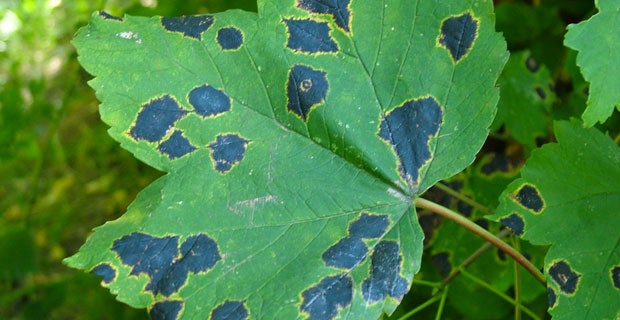Can you compost leaves from a tree with tar spot?
Listen 00:52:56What do you do when you graft a Dirt Doctor and a fruiting spur? Mike McGrath, host of You Bet Your Garden, will be joined by master fruit grower Lee Reich and Texas organic advocate Howard Garrett for a very special show that will include your fabulous phone calls!
Question of the Week:
“A large maple tree in my backyard developed black spots on all of the leaves this year. A maple belonging to my neighbors across the street has the same issue. I believe these may be ‘tar spots’. The trees otherwise seem to be doing fine. I suspect this happened last year as well but I wasn’t paying much attention then. Can I just use the leaves in my compost? Can I use them if I get my compost hot enough? And if so, how do I get it hot enough?”
— Simon in Windsor, Ontario, Canada
Learn more about identifying and using diseased tree leaves »
Highlights from show:
Fig Trees in Winter
Eric from outside of Philadelphia, has about a half a dozen fig trees, and attempts to grow them each year even though they seem to die after each cold winter. He wants to know how to produce them successfully in his garden, and what the issue might be. Lee Reich advises him to bury the figs alive in the ground so the trees won’t be exposed to low temperatures. Eric wants to know if maybe he could bring them into a garage over winter, but Lee warns that the trees still need a bit of cold, so it’s not best to bring them inside. Mike also warns not to use plastic to protect the trees, because it could create a green house effect and warm the trees too much.
Getting Rid of Sandburs
Cathy from outside of Oklahoma City in the country, has severe sandburs, and wants to know how to get rid of them. Howard who can relate to this scenario being an organic gardener in Texas, suggests that she build the available carbon in the soil to generate better growth. Howard believes that is the key to good soil.
Hot and Muggy Gardening Weather
Mona from Orlando, Florida has an herb garden and has a tough time managing the plants due to the hot and muggy weather there. Howard tells Mona to make sure the herbs are in raised beds, and to water very carefully making sure to not over water, which could really damage a plant especially Rosemary. Mike seconds that, saying Rosemary really doesn’t like “wet feet”. Mike says, to try a lot of perlite in the raised beds to improve drainage and retain moisture.
Overgrown Ivy
Andrew from Madison, Tennessee has several hackberry trees on his property. In the front of the yard, he has a huge one that is overgrown with ivy. He’s hacked at it and the vine just keeps coming back. Lee says to just keep an eye on it, and keep hacking away gently. All three suggest to get the ivy out of the tree, which will be beneficial for its growth and health.
Lots of Leaves
Larry from Hollidaysburg, Pennsylvania lives in an area where there are so many leaves, that they had a company come out, and haul away nine dump trucks full, and needs suggestions on the right way to manage all the leaves. Howard recommends that he mulch the leaves into the turf no matter the amount piling up. If there is excess he can put that in a compost pile. Lee then suggests for him to get fencing material and pile the leaves so they can compost down. Lee and Mike disagree on the topic of shredding leaves. Mike is pretty adamant that all the leaves should be shredded to maximize the decomposition. Plus you can fit ten times the amount into bags if they’re shredded.
Fig Tree Trouble
Rita from Coatesville, Pennsylvania ordered a fig tree at one point, nurtured, and planted it while a baby, but as it grew she noticed a cylinder shaped saw dust coming out of the wood and there remained a hole. The tree eventually died. Is this a beetle? Lee thinks it might be the asian ambrosia beetle. He concludes it wasn’t so much the insect killing the tree, but may have been the fungus carried by the beetle killing the stem. Lee continues by adding he doesn’t have a definite cure but a peculiar smell added like cinnamon, and hot pepper painted around the bark might help.
WHYY is your source for fact-based, in-depth journalism and information. As a nonprofit organization, we rely on financial support from readers like you. Please give today.


